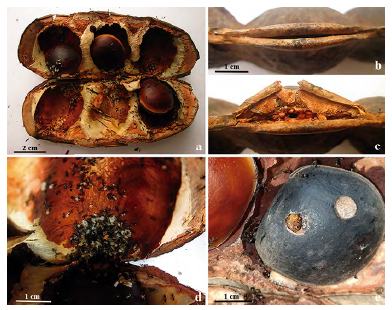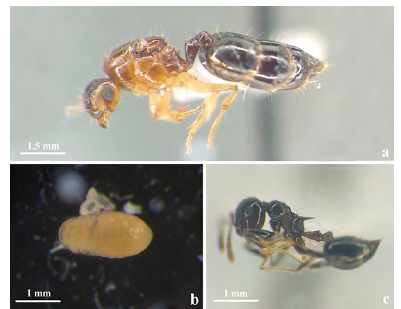The study of the interactions between ants and plants has been widely explored in the last 30 years (Benson, 1984; Beattie, 1985; Jolivet, 1996; Corbara et al., 2019). It is believed that this interaction is the result of co-evolutionary responses by natural selection (Beattie, 1985; Fowler, 1993), where plants provide specialized structures, whose purpose is to supply food or shelter, these structures are called domatia and facilitates the ant nesting (Beattie, 1985). In the tropics there are reported over 400 myrmecophytes plants species belonging to the families Araceae, Bromeliaceae, Chrysobal-anaceae, Cordiaceae, Elaeocarpaceae, Euphorbiaceae, Gen-tianaceae, Gesneriaceae, Lauraceae, Leguminosae, Melasto-mataceae, Meliaceae, Myrtaceae, Orchidaceae, Piperaceae, Polygonaceae, Rubiaceae, Salicaceae, Solanaceae and Urti-caceae (Corbara et al., 2019). Most myrmecophyte domatia develop on vegetative organs such as roots, stems, stipules, and petioles (Jolivet, 1996).
Leguminosae comprises 770 genera and about 19 500 species, with a worldwide distribution (LPGW, 2017). This family interacts with birds, mammals, humans, and arthropods (Charpienter et al., 2015). However, the arthropod-plant interactions need more studies, specially the domatia ant-legume interactions. The contributions done until the date consisted of Pseudomyrmex nests formed on the stipules of Vachellia collinsii (Saff.) Seigler & Ebinger (Janzen, 1966a; Janzen, 1966b), the petioles of Tachigali spp. (Ward, 1999), and the stems of Platymiscium spp. (McKey, 1989; Chomicki et al., 2015), Pterocarpusamazonum (Mart. ex Benth.) Amshoff (Ward, 1999), and Macrolobium acaciifolium (Benth.) Benth (Ward, 1999). Recently, nests on fruits of Mucuna interrupta Gagnep (Kato et al., 2004), Canavalia lineata (Thunb.) DC. and Canavalia cathartica Thouars (Yamashiro and Yamashiro, 2008) have been found.
The ant genus Crematogaster comprises over 500 species, distributed worldwide, with over 120 species in the neotropics (Longino, 2003). In Colombia 27 species are reported (Pedraza and Fernández, 2019). Most species are arboreal and some of them have associations with plants (Longino, 2003). Crematogaster species lives in the domatia of Tillandsia spp. (Longino, 2003), Tococa guianensis Aubl. (Longino, 2003; de Seixas Felizardo, 2010), Protium sp. (Longino, 2003), Triplaris spp. (Longino, 2003), Humboldtia brunonis Wall (Chanam et al., 2014), Vachellia spp. (Longino, 2003) and Macaranga spp. (Feldhaar, 2003). The limata complex is a group of nine species (Longino, 2003). Some species of the complex can nest on Cordia nodosa Lam. and Triplaris spp. (Longino, 2003; de Seixas Felizardo, 2010).
Crematogaster carinata Myer, 1862 inside the limata complex is a Neotropical species distributed from Honduras to Bolivia (Longino, 2003). This species forms small colonies with a single queen, large polygynous colonies or perhaps unicolonial colonies with several queens (Longino, 2003). Furthermore, it forms parabiotic associations with other ants in both polygynous and monogynous forms (Wheeler, 1921) and it nests and forages with other ant genera as Dolichoderus or Odontomachus (Wheeler, 1921).
On the other hand, the legume genus Macropsychanthus Harms ex K. Schum. & Lauterb. comprises over 50 species (Queiroz and Snak, 2020), distributed in the tropics, in Colombia 15 species are reported (Fonseca-Cortés, 2020). Macropsychanthus comosus (G. Mey.) L.P. Queiroz & Snak is a vine distributed in Costa Rica, Panama, Colombia, Peru, Venezuela, Brazil, Guiana, French Guiana, Suriname, Cameroon, Ghana, Liberia, Democratic Republic of the Congo, and Malaysia, and it grows close to the beaches, creeks, roads, and streams (Maxwell, 1969; Fonseca-Cortés, 2020). This species flowers from September to February and fruits until July. Its fruits are oblongs pods, about 15-17 x 5.5-6.0 x 2.5-2.5 cm, with two dorsal ribs, the lower margin of the fruits becomes sulcate and usually open, but not enough to allow the seed scatter, each pod usually contains two to four seeds (Maxwell, 1980; Fonseca-Cortés, 2020).
The objective of this brief note is to report for the firsttime nests done by Crematogaster carinata inside the fruits of Macropsychanthus comusus and to discuss aspects related to the ecological relationships between these two species.
We did fieldwork in three localities of Colombia, two in the village of Guarumo, municipality of Caucasia (7°53' N y 75°12 W), department of Antioquia and one in the village of Los Firmes, municipality of Tíquiso (7°52' N y 75°13' W), department of Bolivar. The localities were located between 70 and 150 m.a.s.l., the study area is characterized by flat relief, temperatures ~ 30 °C, annual precipitation ~1100 mm (Climate-Data, 2020) and sandy loam soils. Formerly, this area was a center for alluvial gold mining and nowadays it is a cattle area with small patches of humid tropical forest.
In each locality we counted the total individuals of Macropsychanthus comosus in a 25 x 2 m transect. We counted and collected the pods attached to the individuals and the fallen ones. Each pod was opened, the insects inside them were collected and the seeds were counted. We additionally recorded if the seeds were damaged or not. The voucher specimens were deposited in the Herbario Nacional Colombiano (COL) under the collection numbers 999 and 1000 of A. Fonseca-Cortés. The insects were deposited in the Colección de Hormigas del Instituto de Ciencias Naturales de la Universidad Nacional de Colombia under the barcodes ICN100281 to ICN 100285
We counted nine plants in the village of Guarumo and eight in the village of Los Firmes. In total we found 32 pods, only seven were attached to the plants. Each pod contained two to four seeds, for a total of 109. Inside the pods we found Crematogaster carinata and a beetle (Coleoptera: Chrysomelidae: Bruchinae). 15 seeds were damaged (14 %) (Fig. 1e) by the bettle larvae. 15 pods presented larvae (Fig. 2b) and workers (47 %) (Fig 2c) and 17 were empty (43 %), seven pods had queens (22 %), only the pods attached to the plants had queens (Fig. 2a).

Figure 1 Domatium in the seed chamber of Macropsychanthus comosus (G. Mey) L.P. Queiroz & Snak by Crematogaster carinata Mayer 1862; a) opened fruit; b-c) nest input; d) nest with larvae and workers; e) drilled seed. Photographs: Andrés Fonseca-Cortés and Esteban Sanabria-Baquero.

Figure 2 Crematogaster carinata; a) queen; b) larvae; c) worker. Photographs: Esteban Sanabria-Baquero and Andrés Fonseca-Cortés
The domatia consist in the locules of the seed chambers (Fig. 1a), in which the queen puts its larvae at the distal part of the locule (Fig. 1d), close to the seed funicle, the nest input is in the lower margin of each locule (Fig. 1b-c). Each locule had a different colony, with one queen protected by the workers.
Kato et al. (2004) reported Crematogaster sp. and Dolicherus thoracicus (Smith, 1860) nesting in the surface of the pods of Mucuna interrupta. Yamashiro and Yamashiro (2008) reported Camponotus bishamon Terayama, 1999, Camponotus vitiosus Smith, 1874, Camponotus nawai Ito, 1914, Ochetellus glaber Jerdon, 1851, and Crematogaster nawai Ito, 1914, nesting inside the pods of Canavalia lineata and Camponotus vitiosus, Tapinoma sp., Technomyrmex albipes Smith, 1861, Monomorium floricola Jerdon, 1851, Ochetellus glaber, Tetramorium bicarinatum Nylander, 1846, Pheidole megacephala Fabricius, 1793, and Cardiocondyla wroughtonii Forel, 1890 in Canavalia cathartica.
In Macropsychanthus comosus only Crematogaster carinata were nesting, despite this species has been reported in parabiosis with Dolichoderus and Odontomachus (Longino, 2003). The reason why this species was found alone is probably for nesting space size, the seeds chambers had a maximum space of 4 x 4 x 4 cm, which is a small chamber for other ants that could be twice or triple the size of C. carinata.
The degree of sociability between the colonies found in the seed chambers of M. comosus is still unknown. It is possible that the colonies could be one polygynous colony as reported by Longino (2003) in the C. carinata populations of Costa Rica.
In the pods of Canavalia lineata, only workers of Crematogaster nawai were found (Yamashiro and Yamashiro, 2008). This species used the pod as satellite stations to enhance the utilization of the extrafloral nectaries (Yamashiro and Yamashiro, 2008). M. comosus apparently do not have extrafloral nectaries, although it had been reported in the brachyblasts of Macropsychanthus ucayalinus (Harms) L.P. Queiroz & Snak as the result of suppressed flowers (as Dioclea ucayalina) (Tucker, 1987). For this the reason, we believe that C. carinata uses the pods of M. comosus as shelter, this hypothesis is supported by the fact that larvae, cocoons and queens were found inside the fruits.
There are three possible ecological explanations for the colonization of the fruits: first, from a hole that were previously made by the beetle (Dos Santos et al., 2016); second, by ant drilling as reported in Acacia (Hocking, 1970) and Vachellia (Janzen, 1966a; 1966b); and finally, by a small natural opening though the lower suture of the pod (com. pers. Luciano Paganucci de Queiroz).
A Bruchidae, Caryedes brasiliensis have been reported consuming 95-100 % of the seeds of M. comosus in Costa Rica (Janzen, 1969; 1971). Here we only found 14 % of the seeds damaged, it could be a positive effect of the presence of Crematogaster carinata, which probably attack some of the adults or the beetle larvae and prevent its development and reproduction.
Macropsychanthus comosus grows near creeks and streams and the fruits are usually swept by the flow, which could kill the ants. in this sense, when the pods fall the ants leave the pods, carrying the larvae.
Some aspects need more research such as, which is the origin of the input?, does the Crematogaster colonization have a protective effect in the seeds success?, are the colonies interconnected or unicolonial?, In which development stage of the pod does the colonization begin?, Which is the beetle that consumed the seeds?. This report points the importance of the research in legume-insect interactions, ant-behavior, trophic webs and trade-off relationships research.















